Rodolfo Valiente
Metacognition for Unknown Situations and Environments (MUSE)
Nov 20, 2024Abstract:Metacognition--the awareness and regulation of one's cognitive processes--is central to human adaptability in unknown situations. In contrast, current autonomous agents often struggle in novel environments due to their limited capacity for adaptation. We hypothesize that metacognition is a critical missing ingredient in adaptive autonomous systems, equipping them with the cognitive flexibility needed to tackle unfamiliar challenges. Given the broad scope of metacognitive abilities, we focus on two key aspects: competence awareness and strategy selection for novel tasks. To this end, we propose the Metacognition for Unknown Situations and Environments (MUSE) framework, which integrates metacognitive processes--specifically self-awareness and self-regulation--into autonomous agents. We present two initial implementations of MUSE: one based on world modeling and another leveraging large language models (LLMs), both instantiating the metacognitive cycle. Our system continuously learns to assess its competence on a given task and uses this self-awareness to guide iterative cycles of strategy selection. MUSE agents show significant improvements in self-awareness and self-regulation, enabling them to solve novel, out-of-distribution tasks more effectively compared to Dreamer-v3-based reinforcement learning and purely prompt-based LLM agent approaches. This work highlights the promise of approaches inspired by cognitive and neural systems in enabling autonomous systems to adapt to new environments, overcoming the limitations of current methods that rely heavily on extensive training data.
Context-Aware Target Classification with Hybrid Gaussian Process prediction for Cooperative Vehicle Safety systems
Dec 24, 2022Abstract:Vehicle-to-Everything (V2X) communication has been proposed as a potential solution to improve the robustness and safety of autonomous vehicles by improving coordination and removing the barrier of non-line-of-sight sensing. Cooperative Vehicle Safety (CVS) applications are tightly dependent on the reliability of the underneath data system, which can suffer from loss of information due to the inherent issues of their different components, such as sensors failures or the poor performance of V2X technologies under dense communication channel load. Particularly, information loss affects the target classification module and, subsequently, the safety application performance. To enable reliable and robust CVS systems that mitigate the effect of information loss, we proposed a Context-Aware Target Classification (CA-TC) module coupled with a hybrid learning-based predictive modeling technique for CVS systems. The CA-TC consists of two modules: A Context-Aware Map (CAM), and a Hybrid Gaussian Process (HGP) prediction system. Consequently, the vehicle safety applications use the information from the CA-TC, making them more robust and reliable. The CAM leverages vehicles path history, road geometry, tracking, and prediction; and the HGP is utilized to provide accurate vehicles' trajectory predictions to compensate for data loss (due to communication congestion) or sensor measurements' inaccuracies. Based on offline real-world data, we learn a finite bank of driver models that represent the joint dynamics of the vehicle and the drivers' behavior. We combine offline training and online model updates with on-the-fly forecasting to account for new possible driver behaviors. Finally, our framework is validated using simulation and realistic driving scenarios to confirm its potential in enhancing the robustness and reliability of CVS systems.
Learning-based social coordination to improve safety and robustness of cooperative autonomous vehicles in mixed traffic
Nov 22, 2022Abstract:It is expected that autonomous vehicles(AVs) and heterogeneous human-driven vehicles(HVs) will coexist on the same road. The safety and reliability of AVs will depend on their social awareness and their ability to engage in complex social interactions in a socially accepted manner. However, AVs are still inefficient in terms of cooperating with HVs and struggle to understand and adapt to human behavior, which is particularly challenging in mixed autonomy. In a road shared by AVs and HVs, the social preferences or individual traits of HVs are unknown to the AVs and different from AVs, which are expected to follow a policy, HVs are particularly difficult to forecast since they do not necessarily follow a stationary policy. To address these challenges, we frame the mixed-autonomy problem as a multi-agent reinforcement learning (MARL) problem and propose an approach that allows AVs to learn the decision-making of HVs implicitly from experience, account for all vehicles' interests, and safely adapt to other traffic situations. In contrast with existing works, we quantify AVs' social preferences and propose a distributed reward structure that introduces altruism into their decision-making process, allowing the altruistic AVs to learn to establish coalitions and influence the behavior of HVs.
Prediction-aware and Reinforcement Learning based Altruistic Cooperative Driving
Nov 19, 2022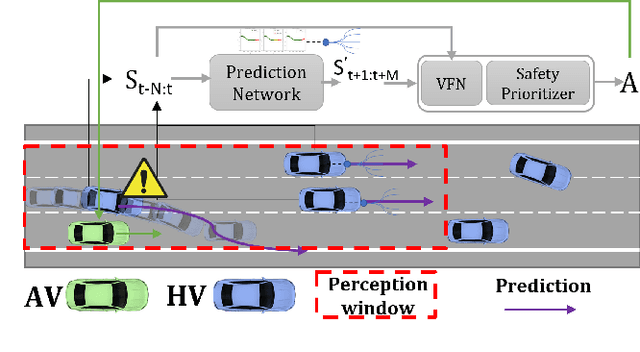
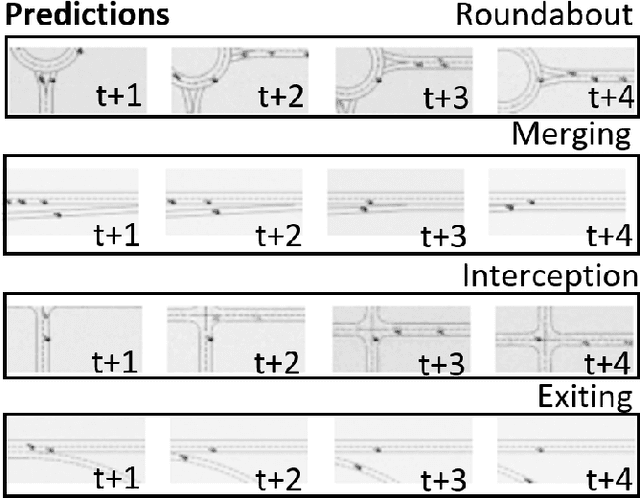

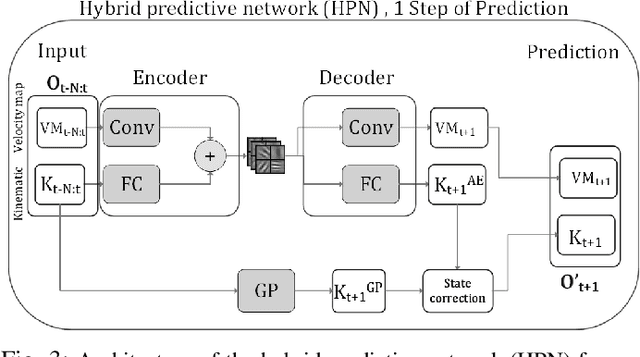
Abstract:Autonomous vehicle (AV) navigation in the presence of Human-driven vehicles (HVs) is challenging, as HVs continuously update their policies in response to AVs. In order to navigate safely in the presence of complex AV-HV social interactions, the AVs must learn to predict these changes. Humans are capable of navigating such challenging social interaction settings because of their intrinsic knowledge about other agents behaviors and use that to forecast what might happen in the future. Inspired by humans, we provide our AVs the capability of anticipating future states and leveraging prediction in a cooperative reinforcement learning (RL) decision-making framework, to improve safety and robustness. In this paper, we propose an integration of two essential and earlier-presented components of AVs: social navigation and prediction. We formulate the AV decision-making process as a RL problem and seek to obtain optimal policies that produce socially beneficial results utilizing a prediction-aware planning and social-aware optimization RL framework. We also propose a Hybrid Predictive Network (HPN) that anticipates future observations. The HPN is used in a multi-step prediction chain to compute a window of predicted future observations to be used by the value function network (VFN). Finally, a safe VFN is trained to optimize a social utility using a sequence of previous and predicted observations, and a safety prioritizer is used to leverage the interpretable kinematic predictions to mask the unsafe actions, constraining the RL policy. We compare our prediction-aware AV to state-of-the-art solutions and demonstrate performance improvements in terms of efficiency and safety in multiple simulated scenarios.
Robustness and Adaptability of Reinforcement Learning based Cooperative Autonomous Driving in Mixed-autonomy Traffic
Feb 02, 2022
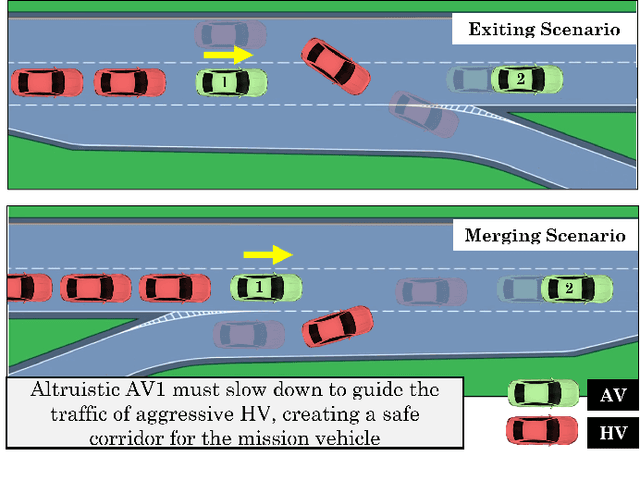
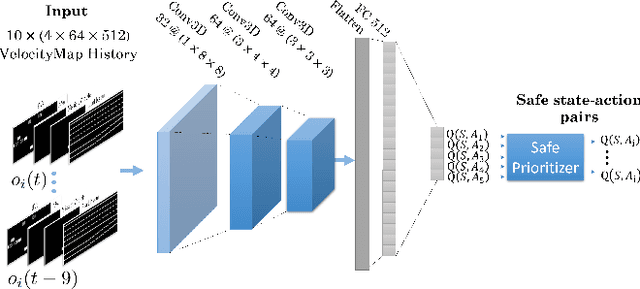
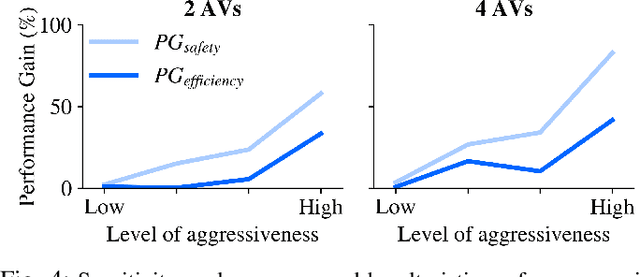
Abstract:Building autonomous vehicles (AVs) is a complex problem, but enabling them to operate in the real world where they will be surrounded by human-driven vehicles (HVs) is extremely challenging. Prior works have shown the possibilities of creating inter-agent cooperation between a group of AVs that follow a social utility. Such altruistic AVs can form alliances and affect the behavior of HVs to achieve socially desirable outcomes. We identify two major challenges in the co-existence of AVs and HVs. First, social preferences and individual traits of a given human driver, e.g., selflessness and aggressiveness are unknown to an AV, and it is almost impossible to infer them in real-time during a short AV-HV interaction. Second, contrary to AVs that are expected to follow a policy, HVs do not necessarily follow a stationary policy and therefore are extremely hard to predict. To alleviate the above-mentioned challenges, we formulate the mixed-autonomy problem as a multi-agent reinforcement learning (MARL) problem and propose a decentralized framework and reward function for training cooperative AVs. Our approach enables AVs to learn the decision-making of HVs implicitly from experience, optimizes for a social utility while prioritizing safety and allowing adaptability; robustifying altruistic AVs to different human behaviors and constraining them to a safe action space. Finally, we investigate the robustness, safety and sensitivity of AVs to various HVs behavioral traits and present the settings in which the AVs can learn cooperative policies that are adaptable to different situations.
Towards Learning Generalizable Driving Policies from Restricted Latent Representations
Nov 05, 2021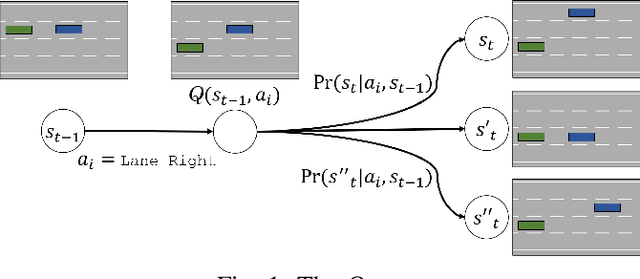

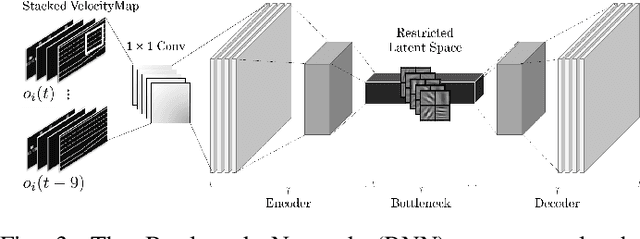
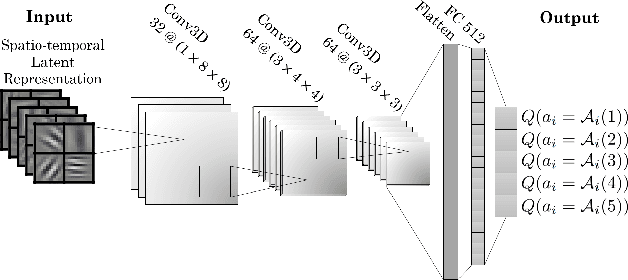
Abstract:Training intelligent agents that can drive autonomously in various urban and highway scenarios has been a hot topic in the robotics society within the last decades. However, the diversity of driving environments in terms of road topology and positioning of the neighboring vehicles makes this problem very challenging. It goes without saying that although scenario-specific driving policies for autonomous driving are promising and can improve transportation safety and efficiency, they are clearly not a universal scalable solution. Instead, we seek decision-making schemes and driving policies that can generalize to novel and unseen environments. In this work, we capitalize on the key idea that human drivers learn abstract representations of their surroundings that are fairly similar among various driving scenarios and environments. Through these representations, human drivers are able to quickly adapt to novel environments and drive in unseen conditions. Formally, through imposing an information bottleneck, we extract a latent representation that minimizes the \textit{distance} -- a quantification that we introduce to gauge the similarity among different driving configurations -- between driving scenarios. This latent space is then employed as the input to a Q-learning module to learn generalizable driving policies. Our experiments revealed that, using this latent representation can reduce the number of crashes to about half.
Social Coordination and Altruism in Autonomous Driving
Jul 20, 2021
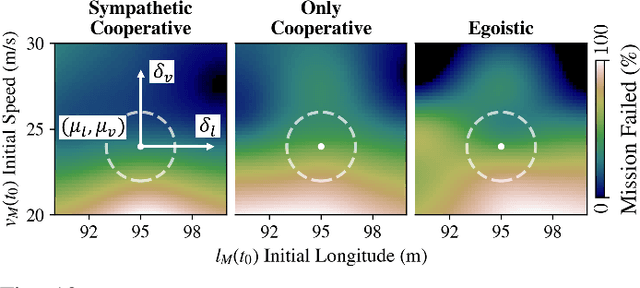
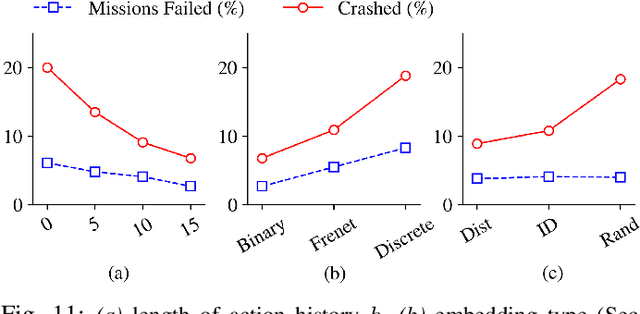

Abstract:Despite the advances in the autonomous driving domain, autonomous vehicles (AVs) are still inefficient and limited in terms of cooperating with each other or coordinating with vehicles operated by humans. A group of autonomous and human-driven vehicles (HVs) which work together to optimize an altruistic social utility -- as opposed to the egoistic individual utility -- can co-exist seamlessly and assure safety and efficiency on the road. Achieving this mission without explicit coordination among agents is challenging, mainly due to the difficulty of predicting the behavior of humans with heterogeneous preferences in mixed-autonomy environments. Formally, we model an AV's maneuver planning in mixed-autonomy traffic as a partially-observable stochastic game and attempt to derive optimal policies that lead to socially-desirable outcomes using a multi-agent reinforcement learning framework. We introduce a quantitative representation of the AVs' social preferences and design a distributed reward structure that induces altruism into their decision making process. Our altruistic AVs are able to form alliances, guide the traffic, and affect the behavior of the HVs to handle competitive driving scenarios. As a case study, we compare egoistic AVs to our altruistic autonomous agents in a highway merging setting and demonstrate the emerging behaviors that lead to a noticeable improvement in the number of successful merges as well as the overall traffic flow and safety.
Altruistic Maneuver Planning for Cooperative Autonomous Vehicles Using Multi-agent Advantage Actor-Critic
Jul 12, 2021

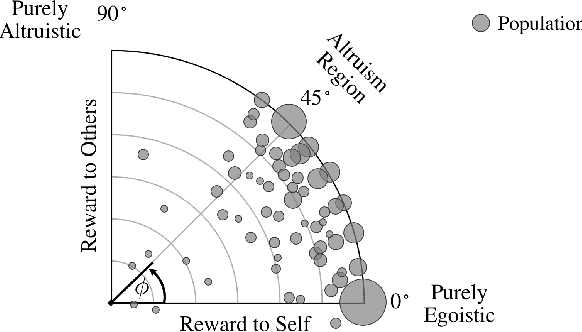
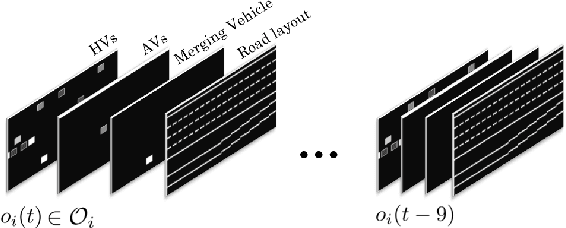
Abstract:With the adoption of autonomous vehicles on our roads, we will witness a mixed-autonomy environment where autonomous and human-driven vehicles must learn to co-exist by sharing the same road infrastructure. To attain socially-desirable behaviors, autonomous vehicles must be instructed to consider the utility of other vehicles around them in their decision-making process. Particularly, we study the maneuver planning problem for autonomous vehicles and investigate how a decentralized reward structure can induce altruism in their behavior and incentivize them to account for the interest of other autonomous and human-driven vehicles. This is a challenging problem due to the ambiguity of a human driver's willingness to cooperate with an autonomous vehicle. Thus, in contrast with the existing works which rely on behavior models of human drivers, we take an end-to-end approach and let the autonomous agents to implicitly learn the decision-making process of human drivers only from experience. We introduce a multi-agent variant of the synchronous Advantage Actor-Critic (A2C) algorithm and train agents that coordinate with each other and can affect the behavior of human drivers to improve traffic flow and safety.
Cooperative Autonomous Vehicles that Sympathize with Human Drivers
Jul 02, 2021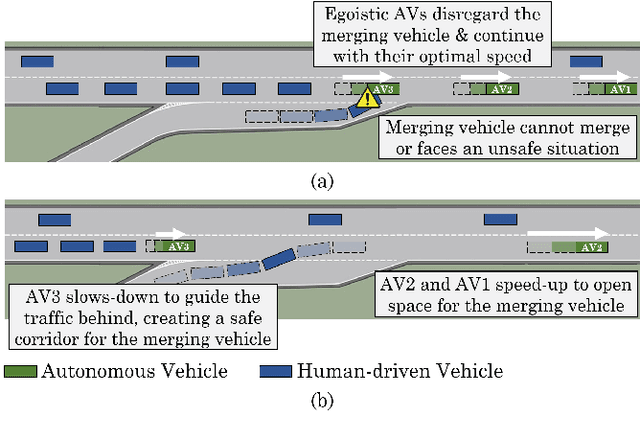
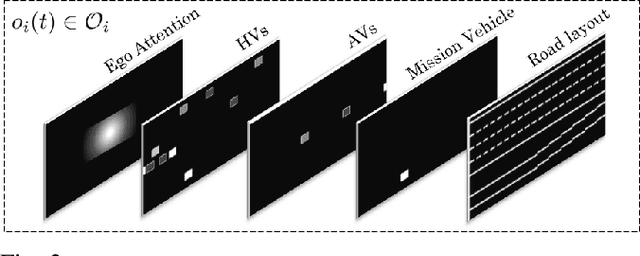
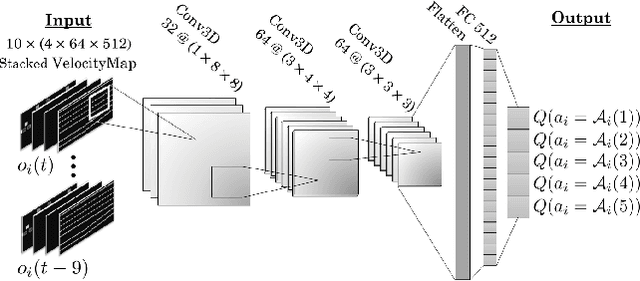
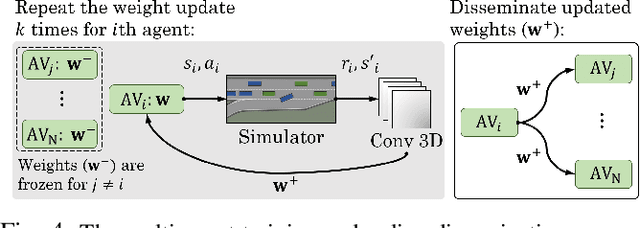
Abstract:Widespread adoption of autonomous vehicles will not become a reality until solutions are developed that enable these intelligent agents to co-exist with humans. This includes safely and efficiently interacting with human-driven vehicles, especially in both conflictive and competitive scenarios. We build up on the prior work on socially-aware navigation and borrow the concept of social value orientation from psychology -- that formalizes how much importance a person allocates to the welfare of others -- in order to induce altruistic behavior in autonomous driving. In contrast with existing works that explicitly model the behavior of human drivers and rely on their expected response to create opportunities for cooperation, our Sympathetic Cooperative Driving (SymCoDrive) paradigm trains altruistic agents that realize safe and smooth traffic flow in competitive driving scenarios only from experiential learning and without any explicit coordination. We demonstrate a significant improvement in both safety and traffic-level metrics as a result of this altruistic behavior and importantly conclude that the level of altruism in agents requires proper tuning as agents that are too altruistic also lead to sub-optimal traffic flow. The code and supplementary material are available at: https://symcodrive.toghi.net/
Controlling Steering Angle for Cooperative Self-driving Vehicles utilizing CNN and LSTM-based Deep Networks
May 12, 2019
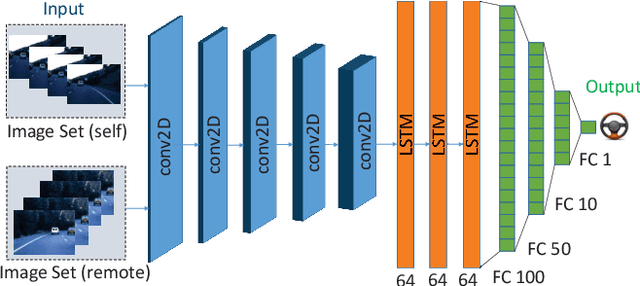

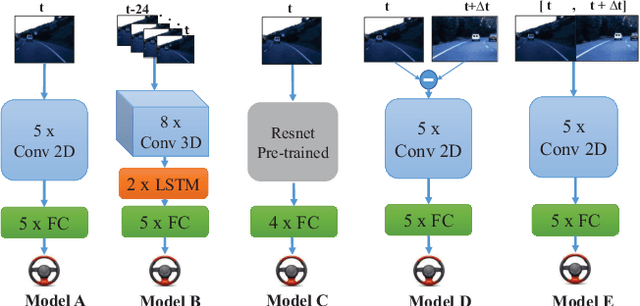
Abstract:A fundamental challenge in autonomous vehicles is adjusting the steering angle at different road conditions. Recent state-of-the-art solutions addressing this challenge include deep learning techniques as they provide end-to-end solution to predict steering angles directly from the raw input images with higher accuracy. Most of these works ignore the temporal dependencies between the image frames. In this paper, we tackle the problem of utilizing multiple sets of images shared between two autonomous vehicles to improve the accuracy of controlling the steering angle by considering the temporal dependencies between the image frames. This problem has not been studied in the literature widely. We present and study a new deep architecture to predict the steering angle automatically by using Long-Short-Term-Memory (LSTM) in our deep architecture. Our deep architecture is an end-to-end network that utilizes CNN, LSTM and fully connected (FC) layers and it uses both present and futures images (shared by a vehicle ahead via Vehicle-to-Vehicle (V2V) communication) as input to control the steering angle. Our model demonstrates the lowest error when compared to the other existing approaches in the literature.
 Add to Chrome
Add to Chrome Add to Firefox
Add to Firefox Add to Edge
Add to Edge